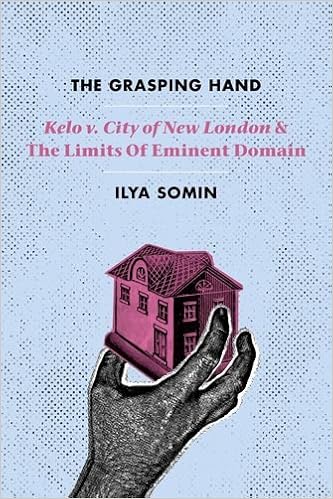 In 2005, the Supreme Court ruled that the city of New London, Connecticut, could condemn fifteen residential properties in order to transfer them to a new private owner. Although the Fifth Amendment only permits the taking of private property for “public use,” the Court ruled that the transfer of condemned land to private parties for “economic development” is permitted by the Constitution – even if the government cannot prove that the expected development will ever actually happen. The Court’s decision in Kelo v. City of New London empowered the grasping hand of the state at the expense of the invisible hand of the market.
In 2005, the Supreme Court ruled that the city of New London, Connecticut, could condemn fifteen residential properties in order to transfer them to a new private owner. Although the Fifth Amendment only permits the taking of private property for “public use,” the Court ruled that the transfer of condemned land to private parties for “economic development” is permitted by the Constitution – even if the government cannot prove that the expected development will ever actually happen. The Court’s decision in Kelo v. City of New London empowered the grasping hand of the state at the expense of the invisible hand of the market.
In this detailed study of one of the most controversial Supreme Court cases in modern times, Ilya Somin argues that Kelo was a grave error. Economic development and “blight” condemnations are unconstitutional under both originalist and most “living constitution” theories of legal interpretation. They also victimize the poor and the politically weak for the benefit of powerful interest groups, and often destroy more economic value than they create. Kelo itself exemplifies these patterns. The residents targeted for condemnation lacked the influence needed to combat the formidable government and corporate interests arrayed against them. Moreover, the city’s poorly conceived development plan ultimately failed: the condemned land lies empty to this day, occupied only by feral cats.
The Supreme Court’s unpopular ruling triggered an unprecedented political reaction, with forty-five states passing new laws intended to limit the use of eminent domain. But many of the new laws impose few or no genuine constraints on takings. The Kelo backlash led to significant progress, but not nearly as much as it may have seemed.
Despite its outcome, the closely divided 5-4 ruling shattered what many believed to be a consensus that virtually any condemnation qualifies as a public use under the Fifth Amendment. It also showed that there is widespread public opposition to eminent domain abuse. With controversy over takings sure to continue, The Grasping Hand offers the first book-length analysis of Kelo by a legal scholar, alongside a broader history of the dispute over public use and eminent domain, and an evaluation of options for reform.



Like is a previous arguement, if the government can make any law they want, are you really free.
This decision may have opened the door for citizens to take property from local, county, state and federal government. Especially property which is not properly maintained. Think about all those broken down vacant school buildings all over the nation.
Men form governmets to protect their rights, among these are the right to property. If government’s purpose is perverted.as to deprive it’s citizens of these righr it serves no purpose and must be abolished.
I think the Supreme Court made a mistake with that ruling. Imminent domain powers were not meant for something as vague as “economic development.” Imminent domain is intended to be used for very specific uses such as public transportation, etc. The term “economic development” is so broad that use of imminent domain for that purpose is inherently arbitrary.
And to put salt on the wound, the economic development fell through and real estate taxes were reduced because the homes were demolished. The only good news was the 45 states which enacted “laws” to protect people from the government.
This is a good example of law-abiding citizens peacefully and legally working withing the system to enact laws to protect people from government abuse of power.
gk, just out of curiosity. What is a valid reason for someone to steal another’s property?
Tom,
That is an easy question. When the property belongs to the government. Or in other words: Communism.
I know, that is why he did not answer.